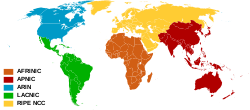IPv4 address shortage
Internet Protocol version 4 (IPv4) has roughly 4.3 billion IP addresses. This became a problem because eventually there were more than 4.3 billion internet-connected computers. This led to a total depletion of IPv4 addresses.
Solutions
IPv6
The long term solution is to switch to Internet Protocol version 6 (IPv6). IPv6 has trillions of trillions of addresses, enough to give every computer in the world a unique IP address. Unfortunately, IPv6 is mostly incompatible with IPv4, and implementing it often requires replacing equipment such as routers. Not all ISPs currently offer IPv6. There are several backward compatibility protocols such as Protocol 41 and Teredo that allow a computer with only an IPv4 address to obtain an IPv6 address.
Network Address Translation
Network Address Translation (NAT) splits a single public IPv4 address into multiple private IPv4 addresses. It is considered a short term solution because it does not usually allow incoming connections without manual configuration of port forwarding.
Carrier-grade Network Address Translation
Carrier-grade Network Address Translation (CGN or CGNAT) is Network Address Translation done by the Internet Service Provider (ISP). It is a short-term solution to provide IPv4 access where the ISP has more customers than public IP addresses. In this setup, multiple customers share a single public IPv4 address. CGN has the major drawback that it does not allow incoming connections at all, because the address translator does not know which customer an incoming connection was intended for. This makes it impossible or very difficult to host services such as websites or file servers. It also causes problems with some online games, online security cameras, and BitTorrent. Most land-line ISPs don't use CGN yet, but mobile providers often do. The address block 100.64.0.0/10 is reserved for CGN, although many ISPs improperly use 10.0.0.0/8 instead. ISPs that use CGN usually offer a public IPv4 address to customers that request one. They may offer this for free, charge a one-time fee, or charge a monthly or yearly fee. In the future they might not offer public IPv4 addresses or might charge a large fee for them, due to supply and demand.
Class E addresses
Another proposal was to assign the class E IPv4 addresses, which are 240.0.0.0 - 255.255.255.254[nb 1], for use on the public Internet. These addresses are currently reserved for "future" or "experimental" use. This would only add about 268 million addresses to the IPv4 Internet - not enough to prevent running out of addresses. Another issue with this approach is that most operating systems (including Windows), routers, servers, and other equipment block these addresses, as they assume that they are invalid. Using these addresses would require updating every computer, router, and server to recognize them as valid - effort which would better be spent on deploying IPv6.[1]
Reassignment of other address blocks
A related proposal is to reassign the 127.0.0.0/8 block, except for 127.0.0.1, for use on the public Internet. These addresses are currently reserved as loopback addresses. As with the class E addresses, reassigning these would also require updating all equipment to recognize them as valid. It has also been proposed to reassign 0.0.0.0/8 (except for 0.0.0.0 itself). Another proposal was to reassign part of the class D block (currently multicast addresses) as unicast addresses. Several other address blocks were already reassigned in 2010 by RFC5735.
IPv4 Address Shortage Media
Notes
- ↑ The address 255.255.255.255, although part of this block, is reserved as the broadcast address.
References
- ↑ "IPv4 Exhaustion: What About Class E Addresses?". PacketLife. Archived from the original on 23 March 2023. Retrieved 5 November 2022.





